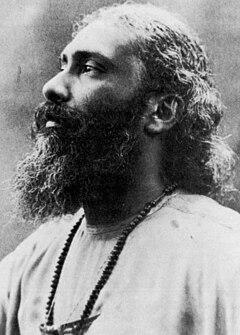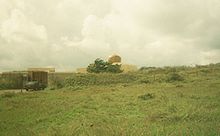| Revision as of 15:05, 14 February 2014 editSergey Moskalev (talk | contribs)331 edits →Books← Previous edit | Revision as of 23:45, 3 April 2014 edit undoArslan-San (talk | contribs)Extended confirmed users4,196 edits →LifeNext edit → | ||
| Line 5: | Line 5: | ||
| ==Life== | ==Life== | ||
| Hazrat Inayat Khan was born in ], ] to a noble ] |
] Inayat Khan Rehmat Khan Pathan was born in ], ] to a noble family, as on his paternal side he descended from ] of ] settled in ], ],<ref>], ''The Message in Our Time: The Life and Teaching of the Sufi Master, Pir-O-Murshid Inayat Khan'', Harper & Row (1978), p. 28</ref><ref>Zia Inayat-Khan, ''A Hybrid Sufi Order at the Crossroads of Modernity: The Sufi Order and Sufi Movement of Pir-o-Murshid Inayat Khan'', ] (2006), p. 80</ref> and his maternal grand-father Moula Bux, called the 'Beethoven of India', founded an Academy of Indian Music in ] and his wife (thus Inayat Khan's maternal grand-mother) was granddaughter of ], the famous eighteenth century ruler of ]). Primarily he represented the ] of ], having received initiation into the Nizamiyya sub-branch of that order from Shaykh ], but was also initiated into the ], ] and ]. His spiritual lineage ('']''), as compiled by Pir Zia Inayat Khan,<ref></ref> follows a traditional lineage from ], through ] (d. 940), the founder of the Chishti order, to ] (d. 1356). | ||
| With the Shaykh's encouragement he left India in 1910 to come to the West, traveling first as a touring musician and then as a teacher of ], visiting three continents. Eventually he married Ora Ray Baker (]), from ], and they had had four children; ] (1914), ] (1916), ] (1917) and Khair-un-Nisa (1919). The family settled in ] near ]. | With the Shaykh's encouragement he left India in 1910 to come to the West, traveling first as a touring musician and then as a teacher of ], visiting three continents. Eventually he married Ora Ray Baker (]), from ], and they had had four children; ] (1914), ] (1916), ] (1917) and Khair-un-Nisa (1919). The family settled in ] near ]. | ||
Revision as of 23:45, 3 April 2014

| Part of a series on |
| Western Sufism |
|---|
 |
|
PersonsInayat Khan Pirani Ameena Begum |
|
GroupsSufi Order Ināyati
Sufism Reoriented Sufi Ruhaniat International |
| BeliefsDances of Universal Peace |
| Places of worshipThe Abode of the Message Universel |
|
Category:Western Sufism |

Inayat Khan (Template:Lang-ur) (July 5, 1882 – February 5, 1927) was the founder of The Sufi Order in the West in 1914 (London) and teacher of Universal Sufism. He initially came to the West as a Northern Indian classical musician, having received the honorific "Tansen" from the Nizam of Hyderabad, but he soon turned to the introduction and transmission of Sufi thought and practice. Later, in 1923, the Sufi Order of the London period was dissolved into a new organization, formed under Swiss law, called the "International Sufi Movement". His message of divine unity (Tawhid) focused on the themes of love, harmony and beauty. He taught that blind adherence to any book rendered religion void of spirit. Branches of Inayat Khan's movement can be found in the Netherlands, France, England, Germany, the United States, Canada, Russia and Australia.
Life
Hazrat Inayat Khan Rehmat Khan Pathan was born in Vadodara, Gujarat to a noble family, as on his paternal side he descended from Pashtuns of Afghanistan settled in Sialkot, Punjab, and his maternal grand-father Moula Bux, called the 'Beethoven of India', founded an Academy of Indian Music in Vadodara and his wife (thus Inayat Khan's maternal grand-mother) was granddaughter of Tipu Sultan, the famous eighteenth century ruler of Mysore). Primarily he represented the Chishti Order of Sufism, having received initiation into the Nizamiyya sub-branch of that order from Shaykh Muhammed Abu Hashim Madani, but was also initiated into the Suhrawardiyya, Qadiriyya and Naqshbandi. His spiritual lineage (Silsila), as compiled by Pir Zia Inayat Khan, follows a traditional lineage from Ali ibn Abi Talib, through Abu Ishaq Shami (d. 940), the founder of the Chishti order, to Nasiruddin Chiragh Dehlavi (d. 1356).
With the Shaykh's encouragement he left India in 1910 to come to the West, traveling first as a touring musician and then as a teacher of Sufism, visiting three continents. Eventually he married Ora Ray Baker (Pirani Ameena Begum), from New Mexico, and they had had four children; Noor-un-Nisa (1914), Vilayat (1916), Hidayat (1917) and Khair-un-Nisa (1919). The family settled in Suresnes near Paris.
In 1922, during a summer school, Inayat Khan had a spiritual experience in the South Dunes in Katwijk, The Netherlands. He immediately told his students to meditate and proclaimed the place holy. In 1969 the Universal Sufi Temple was built there. Khan returned to India at the end of 1926 and there chose the site of his tomb, the Nizamuddin Dargah complex in Delhi where the founder of the Nizami Chishtiyya, Shaykh Nizamuddin Auliya (died 1325), is buried. Khan died shortly after, on February 5, 1927.
Foundational principles
Inayat Khan set forth ten principles that formed the foundational principles of his Universal Sufism:
- There is one God; the Eternal, the Only Being; None exists save He.
- There is one master; the guiding spirit of all souls that constantly leads all followers toward the light.
- There is one holy book; the sacred manuscript of nature, the only Scripture that can enlighten the reader.
- There is one religion; unswerving progress in the right direction toward the Ideal, which fulfills every soul's life purpose.
- There is one law; the law of reciprocity, which can be observed by a selfless conscience, together with a sense of awakened justice.
- There is one brotherhood; the human brotherhood which unites the children of earth indiscriminately in the fatherhood of God. This was later adapted by followers to; "There is one Family, the Human Family, which unites the Children of Earth indiscriminately in the Parenthood of God."
- There is one moral; the love which springs forth from self-denial and blooms in deeds of beneficence. ... (later alternative; "which springs forth from a willing heart, surrendered in service to God and Humanity, and which blooms in deeds of beneficence").
- There is one object of praise; the beauty which uplifts the heart of its worshipper through all aspects from the seen to the unseen.
- There is one truth; true knowledge of our being, within and without, which is the essence of Wisdom.
- There is one path; annihilation of the false ego in the real (later alternative; "the effacement of the limited self in the Unlimited"), which raises the mortal to immortality, in which resides all perfection.
Inayat Khan's emphasis on spiritual liberty led many contemporary Westerners to think that his brand of Sufism is not inherently intertwined with Islam, although his followers continue to perform (Dhikr). There is a precedent of masters of the Chishti and some other orders not requiring non-Muslim followers to convert to Islam. The number of non-Muslim Sufis before the twentieth century, however, was usually relatively few.
Books
- Inayat Khan, Hazrat (Prof. 'Ināyat-khān flahmat-khān Pathān). Inäyat gīt ratnāvalī. Baroda and Mumbai: The Auspices of the Government of Sayājīrāo Maharaja Gaekwar, 1903. (Gujarati)
- Inayat hārmoniyam siksak pustak pahalā. Baroda and Mumbai: The Auspices of the Government of SayājMo Mahāiäjā Gāekwār, 1903. (Gujarati. Scores and songs)
- Inayat phidd, siksak. Baroda and Mumbai: The Auspices of the Government of Sayājīrāo Maharaja Gāekwār, 1903. (Gujarati. Scores)
- Minqār-i mūslqār. Allahabad: Indian Press, 1912. (Urdu. Encyclopedia of Indian music and dance).
- A Sufi Message of Spiritual Liberty. London: The Theosophical Publishing Society, 1914.
- Songs of India. London: The Sufi Publishing Society, 1915.
- Hindustani Lyrics. London: The Sufi Publishing Society, 1919.
- "Pir-o-Murshid's Address." The Sufi Quarterly, January, 1920.
- The Unity of Religious Ideals. London: The Sufi Movement, 1921.
- Nirtan or the Dance of the Soul. London: The Sufi Movement, 1928.
- The Divine Symphony or Vadan. London/Southampton: The Sufi Movement, 1931.
- Rasa Shastra: The Science of Life's Creative Forces. Deventer: Kluwef, 1938.
Articles
- "Moula Bux." The Sufi Quarterly 1, no. 3,1915.
- "The Music of India." The Sufi Quarterly 2, April 1916.
Music
- Song "Yaman Kalyan Khyal" by Inayat Khan recorded in Calcutta 1909
- «Hindustani songs by prof. Inayat Khan» 16 melodies for piano (1915). Performed by Philip Sear
- «Hindustani songs by prof. Inayat Khan» (scores PDF)
References
- Vilayat Inayat Khan, The Message in Our Time: The Life and Teaching of the Sufi Master, Pir-O-Murshid Inayat Khan, Harper & Row (1978), p. 28
- Zia Inayat-Khan, A Hybrid Sufi Order at the Crossroads of Modernity: The Sufi Order and Sufi Movement of Pir-o-Murshid Inayat Khan, ProQuest (2006), p. 80
- Silsila / Shajara – The Chain of Spiritual Transmission
- In The Spiritual Message of Inayat Khan, Volume I – The Way of Illumination, VOLUME I – I – 1 at wahiduddin.net
- Carl Ernst and Bruce Lawrence, Sufi Martyrs of Love, New York: Palgrave Macmillan, 2002, p.142. ISBN 1-4039-6027-5.
| Part of a series on Islam Sufism |
|---|
 |
| Ideas |
| Practices |
Sufi orders
|
| List of sufis |
| Topics in Sufism |
|
|